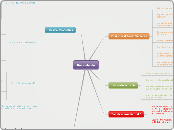Periodicity
First-row d-block Elements
List the characteristic properties of transition elements
Explain why Sc and Zn are not considered to be transition elements
Explain the existence of variable oxidation number in ions of transition elements
Describe and explain the formation of complexes of d-block elements
Define the term ligand
Explain why some complexes of d-block elements are coloured
State examples of the catalytic action of transition elements and their compounds
Outline the econimic significance of catalysts in the Contact and Haber processes
The Periodic Table
Elements are placed in order of increasing atomic no. (Z)
The rows are the periods and the columns are the groups
The period refers to the number of energy levels occupied and the group, to the number of electrons in the valence shell
The number of electrons in the valence shell gives an element its group number
Trends across Period 3
Explain the physical states (under standard conditions) and electrical conductivity (in molten state) of the chlorides and oxides of the elements in Period 3 in terms of their bonding and structure
Describe the reactions of chlorine and the chlorides referred to in 13.1.1 with water
Physical Properties
The fiirst ionization energy of an element is the energy required to remove one mole of electrons fron on mole of gaseous atoms.electronegativity
Electronegativity is the ability of an atom to attract electrons in a covalent bond
The effective nuclear charge felt by an atom's valence electrons increases with the group number of the element. it increases across a period but stays approximately the same down the group
Sheilding is where an electron is sheilded from the full attrcation of the nucleus
Li --> Cs (down the alkali metals)
Atomic radius increases due to increased electron shielding.
Ionic radius increases due to increased electron shielding.
Ionisation energy decreases due to increased electron shielding.
Melting/boiling point decreases due to increased electron shielding --> decreased forces.
Electronegativity decreases due to increased shielding --> decreased attraction for outer electrons.
F --> I (Down the halogens):
Atomic radius increases due to increased electron shielding.
Ionic radius increases due to increased electron shielding.
Ionisation energy decreases due to increased electron shielding.
Melting/boiling point increases due to increased number of electrons->increased london dispersion forces.
Electronegativity decreases due to increased shielding -> decreased attraction for outer electrons.
Na --> Ar (across period 3):
Atomic radius decreases due to increased nuclear charge --> greater attraction for electrons.
Ionic radius decreases Na --> Al (due to increased nuclear charge) jumps Al --> Si (due to reversal of ionisation direction...increased electron-electron repulsion) decreases Si --> Ar (due to increased nuclear charge).
Ionisation energy increases due to increased nuclear charge.
Electronegativity increases due to increased nuclear charge --> greater attraction for electrons.
Compare the relative electronegativity values of two or more elements based on their positions in the Periodic Table
Chemical Properties
Largely determined by the number of electrons in the valence shell of an element
Discuss the similarities and differences in the chemical properties of elements in the same group
Reactions of elements in the same group are similar because they have identical outer shells
Look at link 3.3.1
Discuss the changes in nature, from ionic to covalent and from basic to acidic, of the oxides across Period 3
Elements on the left are metallic, right are non-metals, Al is a metalloid (semi-metal).
Look at link 3.3.2
